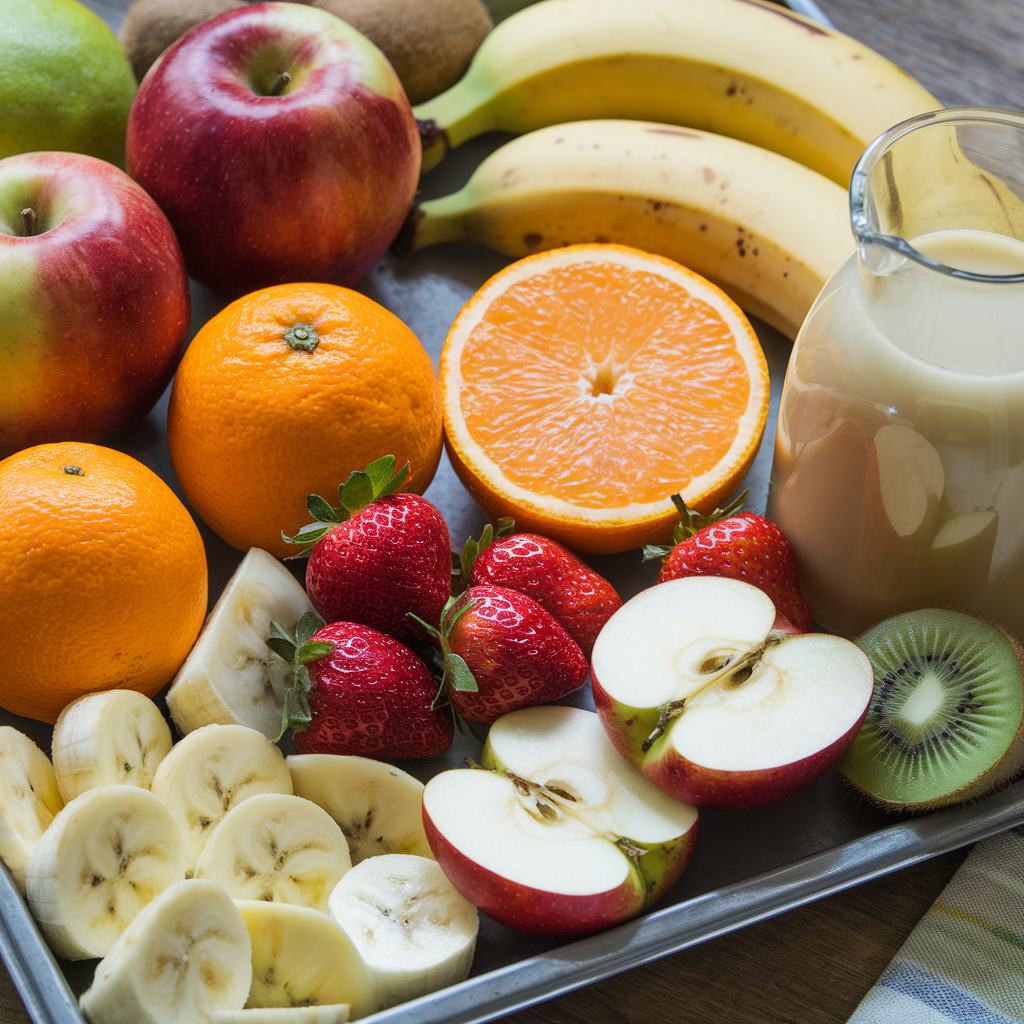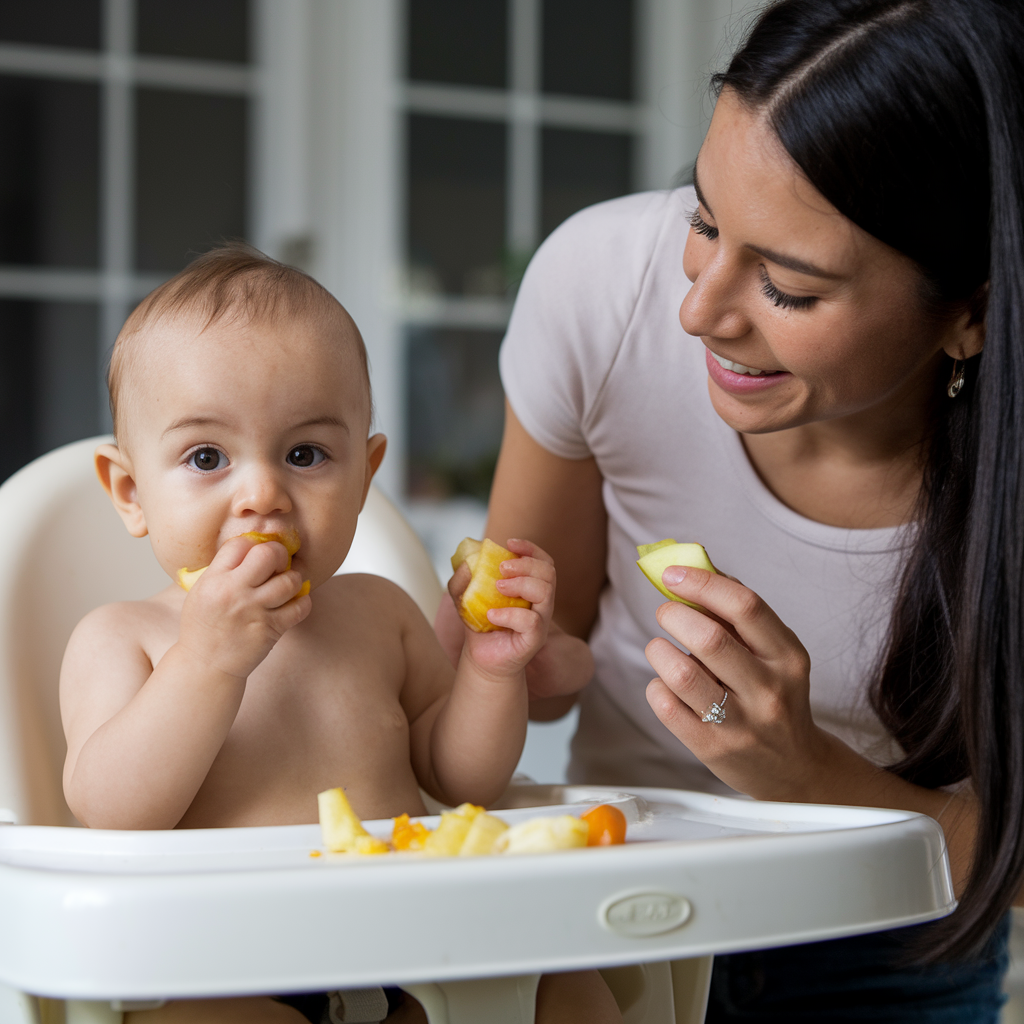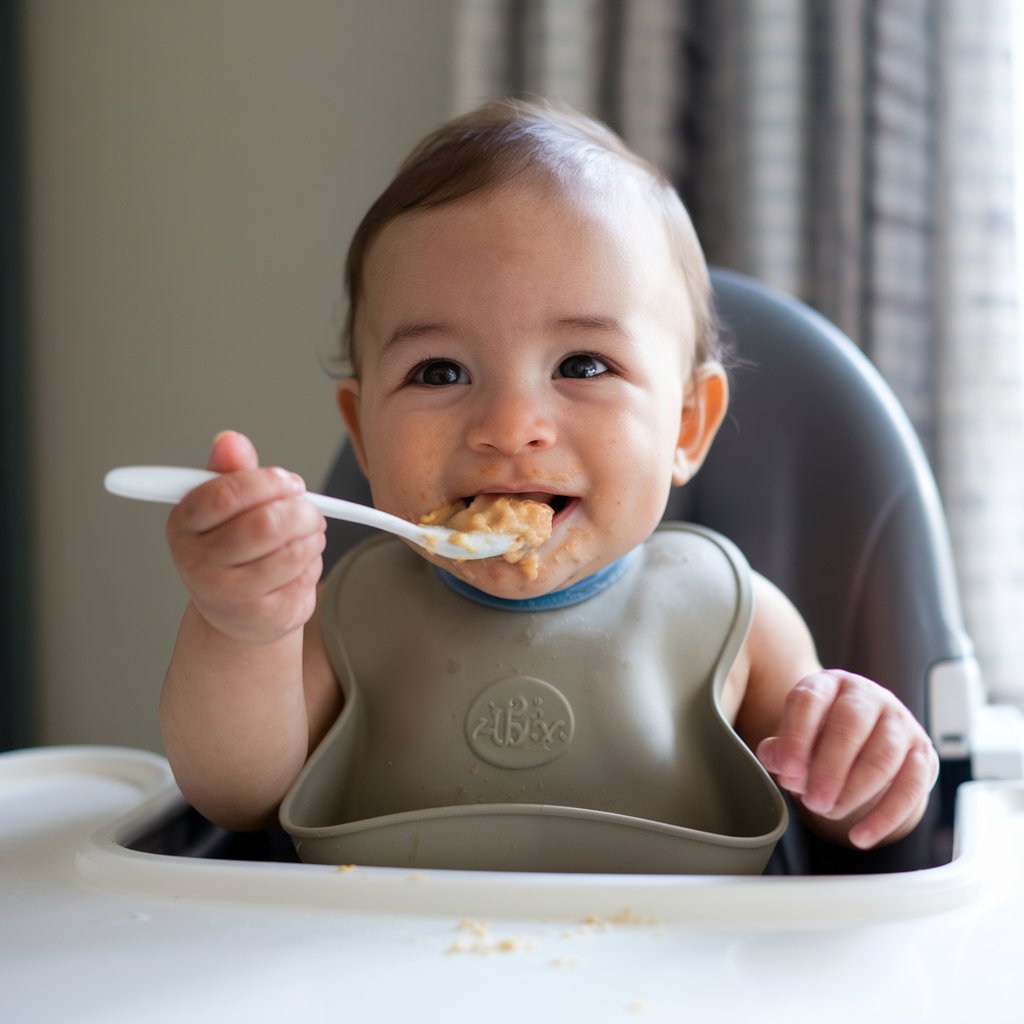Physical Address
304 North Cardinal St.
Dorchester Center, MA 02124
Physical Address
304 North Cardinal St.
Dorchester Center, MA 02124
Introducing fruits to your baby can be an exciting time filled with new flavors and textures. Starting with fruits helps create healthy eating habits early on. Knowing when and how to introduce these foods can make the process smoother for both you and your little one.

As you embark on this journey, remember to choose fruits that are safe and suitable for your baby’s age. Preparing these fruits properly ensures that your baby enjoys a delightful first experience with solid foods. With a little patience and creativity, you can make fruit time enjoyable and nutritious for your child.
Baby nutrition is crucial for healthy growth and development. Introducing the right foods at the right time can set the stage for good eating habits later on. Fruits are an essential part of this journey, providing vitamins and flavors that help your baby thrive.
Fruits are a great addition to your baby’s meals. They offer natural sweetness and vibrant colors, making them appealing to little ones. By introducing fruits early, you help your baby develop a taste for healthy foods.
Starting at around 6 months, you can offer pureed or soft fruits as part of their diet. Options like bananas, apples, and pears are easy to mash and are gentle on tiny tummies. Incorporating fruits into your baby’s diet can also encourage healthy habits, as kids who enjoy fruits often continue to eat them as they grow.
Fruits pack a nutritional punch. They are full of essential vitamins, such as vitamin C, which boosts the immune system. Many fruits also provide fiber, helping your baby’s digestive health.
Some nutritious fruits for babies include:
By choosing a variety of fruits, you ensure that your baby gets a balanced intake of nutrients. This can support their overall health and well-being.
Introducing fruit to your baby is an exciting time. Knowing when and how to start can help ensure a smooth transition to solid foods.
Before introducing fruit, look for signs that your baby is ready for solid foods. These signs include:
If you notice these signs, your baby may be ready to try mashed or pureed fruits. Remember to start with small amounts and observe how your baby reacts.
Most babies can start eating solid foods, including fruit, around 6 months of age. This age is significant as babies usually begin to show signs of readiness for solids around this time.
Start with single-grain cereals or pureed vegetables before moving to fruit. Good first fruits include mashed bananas, applesauce, or pureed pears.
Be sure to avoid honey and whole nuts until after 1 year of age, as these can pose choking hazards or other risks. Always consult with your pediatrician if you have concerns about introducing new foods.
Selecting the right fruits for your baby is crucial for their health and enjoyment. You’ll want to ensure those fruits are safe to eat and watch for any allergies that might arise.
When introducing fruits, start with soft, easily digestible options. Good choices include:
Make sure to serve these fruits plain or as purees. Cut them into small, manageable pieces when your baby is ready for more solid foods. Always choose fresh, ripe fruits to ensure the best taste and nutrition.
Introducing new foods can sometimes lead to allergies. Here are a few tips to help you manage this risk:
Consult your doctor before introducing high-risk fruits, especially if allergies run in your family. Keeping track of what your baby eats can help you recognize any patterns over time.
When introducing fruits to your baby, it’s essential to prepare them properly. This ensures that they are safe, nutritious, and appealing to your little one. Below are some key methods to prepare fruits effectively.
Before you prepare any fruit, start with a good wash. Rinse all fruits under running water to remove dirt and bacteria. For fruits with skins, like apples and pears, gently scrub the surface with a produce brush.
Make sure to dry them with a clean towel afterward. If you’re using organic fruits, washing is still necessary to remove any residual pesticides.
After washing, cut away any bruised or damaged areas as these can harbor harmful bacteria. Keeping fruits clean is your first step to ensuring your baby’s health.
Some fruits, like apples and pears, can be cooked to soften them and make them easier to eat. Peel and chop the fruit, then steam or boil until tender.
Once cooked, use a blender or food processor to puree the fruit to a smooth consistency. You can add a little breast milk or formula to thin out the puree if needed.
If you’re using fruits like bananas or avocados, they can be mashed without cooking. Just mash them with a fork until smooth. Remember, always test the temperature before serving to your baby to avoid burns.
As your baby grows, you can introduce different textures. Start with smooth purees for younger babies, as they are easier to swallow.
Once your baby shows they can handle smooth fruits, gradually introduce chunky textures. For example, offer mashed bananas with small chunks or finely chopped peaches.
This change helps your baby learn to chew and enjoy a variety of flavors. Always watch your baby while they eat to ensure they are comfortable with each new texture. Keep it fun and engaging!
Introducing fruit to your baby can be a fun adventure. Choosing the right feeding technique and managing the process can make a big difference in this new phase. Here are some important tips to help you navigate feeding your little one.
When introducing fruit, you can choose between baby-led weaning and spoon-feeding. Baby-led weaning allows your baby to explore whole pieces of fruit. This method encourages self-discovery and can be a great way for them to develop motor skills. Start with soft fruits like ripe bananas or cooked apple slices.
On the other hand, spoon-feeding involves mashing or pureeing fruit. This can make it easier for babies to swallow and digest. Work with smooth textures to start. You can blend or mash fruits like peaches, pears, or avocados for a nutritious option.
Encouraging your baby to self-feed is important. Provide small, manageable pieces of soft fruit that they can hold easily. Fruits like melon cubes and soft berries can be great choices.
Use a high chair or sitting area where your baby feels comfortable. Let them grab the food and explore at their own pace. This helps them learn how to chew and swallow while also making mealtime enjoyable.
Be patient, as it may take time for your baby to get the hang of it. Celebrate their efforts, and don’t worry about mess; it’s all part of the process!
Feeding little ones can be messy, and that’s completely normal. To manage mess, place a protective mat under the high chair. This will help catch any spills.
Prepare for some fruit wastage by offering small portions. If your baby is not interested, simply save the leftovers for later. You can also try using a bib with a pocket to catch dropped pieces, making cleanup easier.
Remember that mealtime is a learning experience. Staying calm and relaxed will help your baby feel comfortable during their fruit exploration. Enjoy these messy moments together!

As you introduce fruit to your baby, it’s essential to keep an eye on how they react. This can help you identify any possible allergies or digestive issues. Understanding your baby’s responses will ease your worries and ensure a smooth transition to solid foods.
When introducing new fruits, watch closely for signs of allergic reactions. These can occur within minutes to a few hours after eating. Common symptoms include:
If you notice any of these symptoms, stop giving the fruit immediately. Consult your pediatrician to discuss your observations. They may recommend an allergy test or suggest alternative foods. Always introduce one fruit at a time to monitor for possible reactions. This way, if an allergy occurs, you’ll know exactly what caused it.
As your baby adjusts to eating fruit, pay attention to their digestion. Fruits can sometimes cause gas or a change in bowel movements. Look for:
If you notice consistent digestive issues, it’s wise to keep a food diary. Write down what your baby eats, along with any reactions. This can help you and your pediatrician pinpoint any troublesome fruits, making future feedings smoother.

As your baby grows, it’s important to expand their diet by introducing combination foods. This allows them to experience new flavors and textures, making mealtime more enjoyable and varied. Here are some key ways to mix fruits into your baby’s diet.
Combining fruits with other foods can create tasty and nutritious meals for your baby. You can mix pureed fruits with cereals or yogurt. For example, try blending mashed bananas with oatmeal for added sweetness and nutrition.
Consider incorporating cooked sweet potatoes or pumpkin with apples or pears. This not only enhances the flavor but also provides important vitamins. Always ensure that the textures are age-appropriate, starting with purees for younger babies.
As your baby adjusts, you can gradually increase the chunkiness of the mixtures. This helps to develop their chewing skills. Don’t hesitate to experiment with different combinations to find out what your baby enjoys the most.
Once your baby is comfortable with purees, you can start introducing small pieces of soft fruit. Soft fruits like ripe bananas, cooked apples, or pears are great options. Make sure to cut them into small, manageable pieces to prevent choking.
As your baby develops their pincer grasp, encourage them to pick up pieces of fruit themselves. This not only enhances their motor skills but also makes mealtime more interactive. You can also try offering finger foods like small slices of peach or melon.
Remember to supervise your baby while they eat, and always be cautious about allergies. Offer each new fruit separately to monitor any reactions. This transition to finger foods sets the stage for healthier eating habits as they grow.
When introducing fruit to your baby, it’s important to focus on a balanced diet. This means offering a range of foods while ensuring your baby gets the nutrients needed for healthy growth. You can do this by incorporating various fruits and being mindful of not leaning too much on sweet options.
Introduce your baby to different fruits to create a colorful and appealing plate. This not only helps to make mealtime fun but also ensures they receive a mix of vitamins and minerals.
Try to include:
Aim for two to three servings of fruit each day. Remember that variety encourages healthy eating habits that can last a lifetime.
While fruits are generally good for your baby, some are sweeter than others. If you focus too much on sweet fruits like bananas and grapes, your baby may develop a preference for sugary tastes.
To balance this, offer fruits that are less sweet, such as:
Mix sweet fruits with these options to teach your baby to enjoy a range of flavors. This helps support healthy eating habits from an early age.

Introducing fruits to your baby can be exciting! It’s important to know the best practices, safe options, and when to start. Here are some common questions that can help guide you.
Start with single-ingredient purees. This allows your baby to try one fruit at a time and helps you spot any allergic reactions. Use a fork or blender to make smooth, soft purees that are easy for your baby to swallow.
Safe options include bananas, avocados, and cooked apples. These fruits are soft and easy to digest, making them great first choices. Always ensure they are mashed or pureed to avoid any choking hazards.
Most parents start introducing fruit around 6 months of age. This is when babies are usually ready for solid foods, along with breast milk or formula. Consult your pediatrician if you’re unsure about your baby’s readiness.
Some easy-to-digest fruits include bananas, pears, and cooked apples. These fruits are gentle on the stomach and less likely to cause gas. Always offer them in a pureed or mashed form at first.
You can offer fruits 2 to 3 times a week as part of a varied diet. Start slowly and gradually increase the frequency as your baby gets used to different textures and flavors.
Yes, certain fruits should be avoided. Citrus fruits like oranges can be too acidic and may upset your baby’s stomach. Additionally, strawberries and other common allergens should be introduced carefully and preferably after the first year.